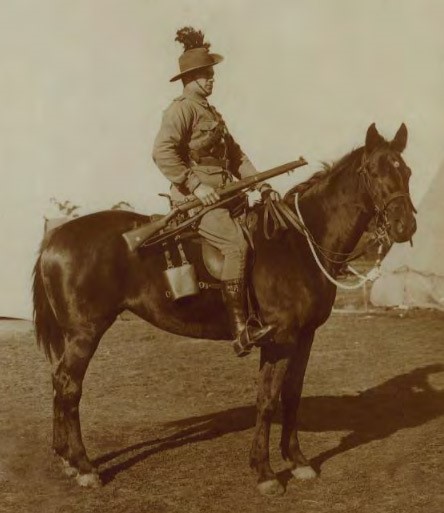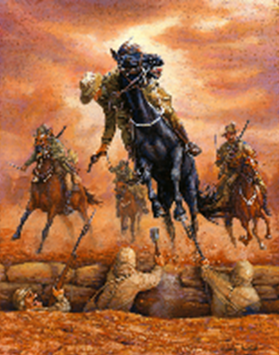Midnight was born at midnight on October 31, 1905 on the Bloomfield stud property in the Hunter Valley, NSW. She was a jet black horse with a white star with 3 points like a tiara on her head. Her mother’s name was Moonlight and her father’s name was Tester. He had been a champion race horse. Midnight inherited her father’s speed and her mother’s stamina. Guy Haydon was 16 when she was born on their property and she became Guy’s special horse. Guy was an excellent horseman and he trained her well in his duties around the farm.
 When the war broke out Guy enlisted in the army together with his younger brother, Barney, and his horse, Polo. They joined the 12th Light Horse regiment. They sailed off to war in June 1915 and arrived in Cairo six weeks later. There they trained further in the desert before sending some of the troops to Gallipoli. However, when the two brothers were sent into action at the end of August 1915, they had to leave their horses behind. After returning to Cairo, Guy was initially assigned another horse but was eventually reunited with his beloved mare. The troops did more training in the desert sands and a rivalry arose between the British and the ANZACs as to which were the best horsemen and horses. The “Desert Olympics” were held and Guy and Midnight were chosen to represent the ANZACs. There were three events – a sprint, an obstacle race, and dressage. Guy and Midnight won all three!!!
When the war broke out Guy enlisted in the army together with his younger brother, Barney, and his horse, Polo. They joined the 12th Light Horse regiment. They sailed off to war in June 1915 and arrived in Cairo six weeks later. There they trained further in the desert before sending some of the troops to Gallipoli. However, when the two brothers were sent into action at the end of August 1915, they had to leave their horses behind. After returning to Cairo, Guy was initially assigned another horse but was eventually reunited with his beloved mare. The troops did more training in the desert sands and a rivalry arose between the British and the ANZACs as to which were the best horsemen and horses. The “Desert Olympics” were held and Guy and Midnight were chosen to represent the ANZACs. There were three events – a sprint, an obstacle race, and dressage. Guy and Midnight won all three!!!
Midnight performed well in the harsh conditions in the desert battles on the Sinai peninsula. The Waler horses, which had been trained in the Australian bush, had stamina and strength needed to withstand the 50 degree desert summer temperatures and the long tiring treks, mostly at night. The 12th Light Horse regiment were part of the battle of Gaza. When this failed, the General Chauvel decided to trek inland and take the city of Beersheba. After riding for several nights and trying to sleep by day, on arrival at Beersheba the soldiers had to fight all day.  As the sun was about to set, the 12th Light Horse regiment were ordered to line up and charge for the city and its precious ancient wells of Abraham.
As the sun was about to set, the 12th Light Horse regiment were ordered to line up and charge for the city and its precious ancient wells of Abraham.
800 Light Horsemen defeated 4,000 entrenched Turks in a reckless charge, coming so fast and jumping the trenches before galloping into town to the wells. The horses smelled the water and the riders could not stop them.
Unfortunately, Midnight and Lieutenant Guy Haydon, were two of the casualties that day. A bullet went through Midnight’s stomach as she jumped the trench, continued through the saddle and lodged in Guy’s back, millimetres from his spine. Guy eventually recovered but Midnight did not. This magnificent black thoroughbred had sacrificed her life but saved Guy’s.
Guy was left lying in agony in the pit with the bullet wound in his back. There was carnage all round him. Four of his mates died right next to him. He humbly accounts that there were others worse off than him, given the groans of agony he could hear. His beloved mare was lying dead just near the pit. It was a long freezing painful night. The longest in his life.
Major Fetherslonehaugh writes “Guy would not allow them to take him in that night as there were others he considered worse cases than him, so he stayed out all night.........you will all be very proud of your gallant, self-sacrificing son. God bless him for staying out all night so that other cases could be attended to.......he deserves a decoration.”1
 He was eventually moved the following morning and sent by train to El Arish then on to Cairo, arriving five days after the charge. The bullet was removed but infection was a problem and he had ongoing problems from the wound for the rest of his life. His family still have the bullet that was removed.
He was eventually moved the following morning and sent by train to El Arish then on to Cairo, arriving five days after the charge. The bullet was removed but infection was a problem and he had ongoing problems from the wound for the rest of his life. His family still have the bullet that was removed.
Back in Australia, after finally recovering, he became a grazier, but was greatly involved in community work, serving on several local boards including a government committee for resettling ex-servicemen and as a city councillor for the Tamarang shire. He had three children, the first being born while he was serving overseas. He passed away in August 1965, aged 76.
Barney survived the charge and rode on into town to secure the wells. He and Polo made it right through to the armistice and he later returned to Australia to become a leading horse judge.
The extended Haydon family had 13 sons who served in the World War 1 including Stuart Haydon who was one of the first killed on arrival at the beach in Gallipoli.
Endnotes:
Pictures:
- http://www.haydonhorsestud.com.au/news/midnight-the-full-story/
- https://theflyingshetlands.wordpress.com/2016/04/09/midnight-the-story-of-a-light-horse-tells-a-story-of-war-horses-in-a-part-of-world-war-i/
- Midnight’s Last Charge – painting by Jennifer Marshall www.lighthorseart.com.au

